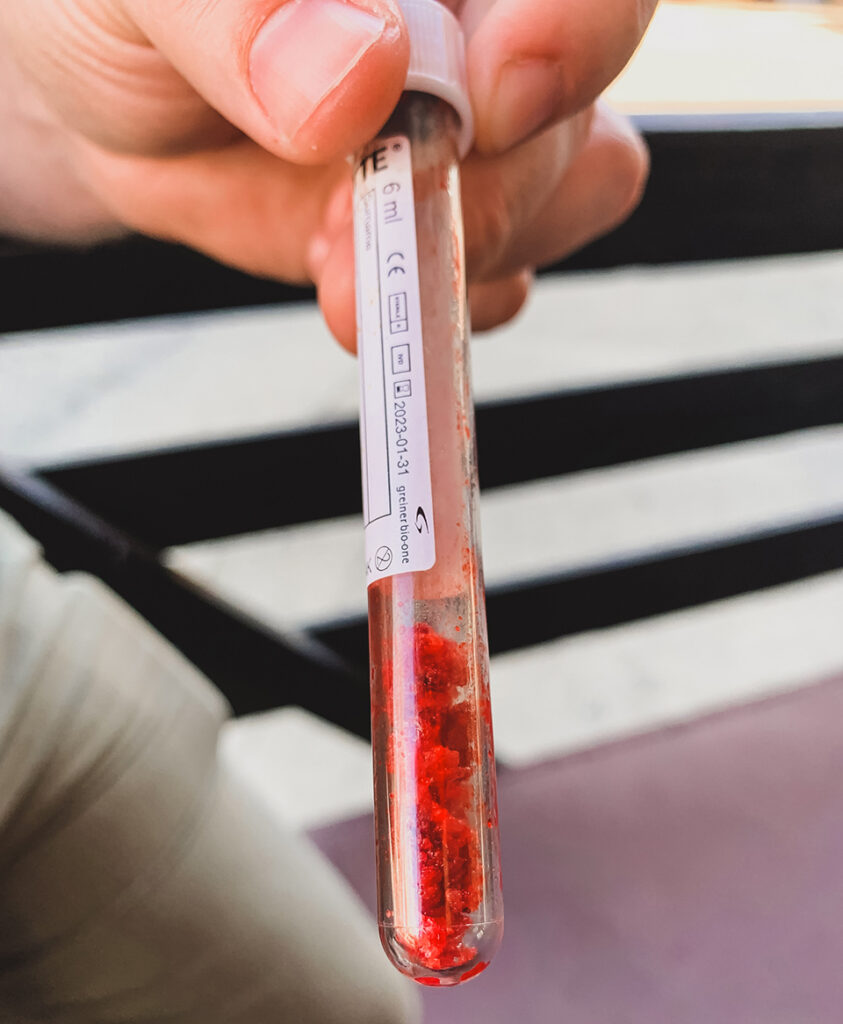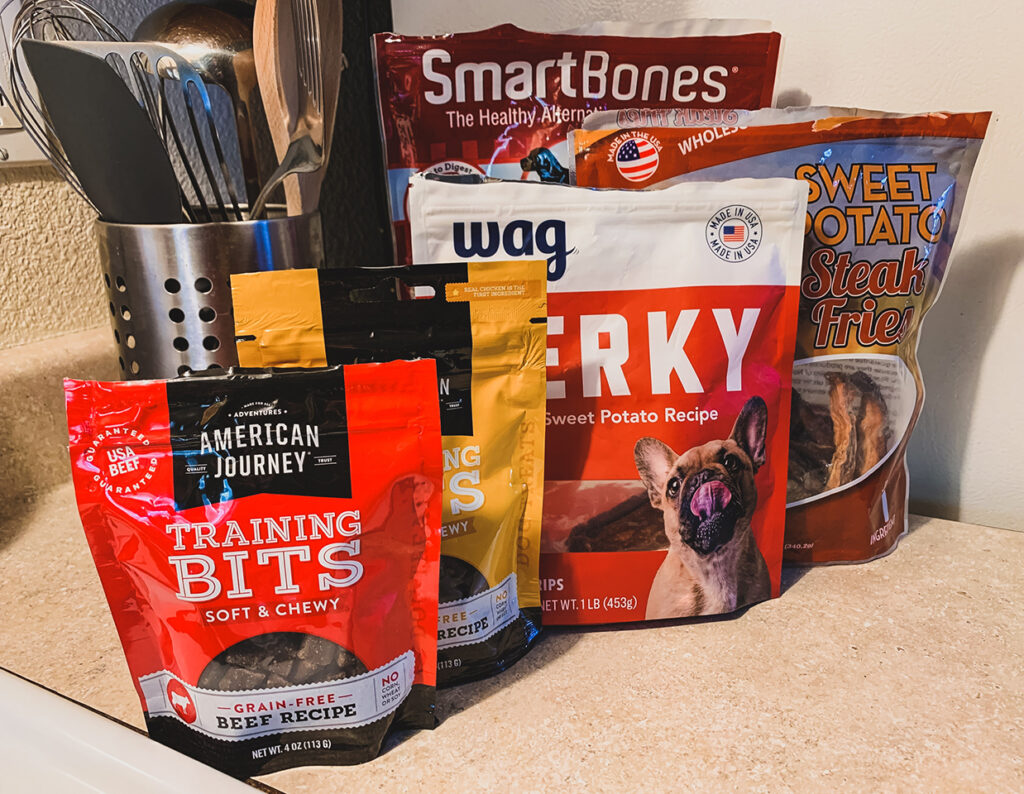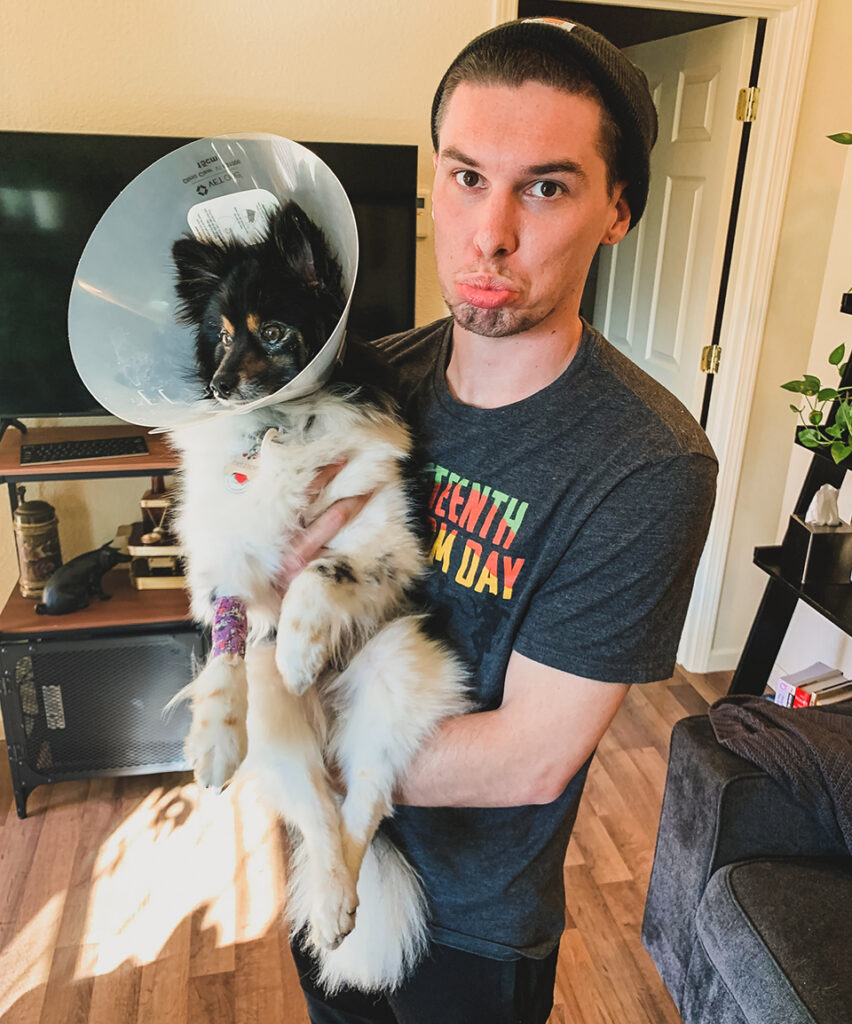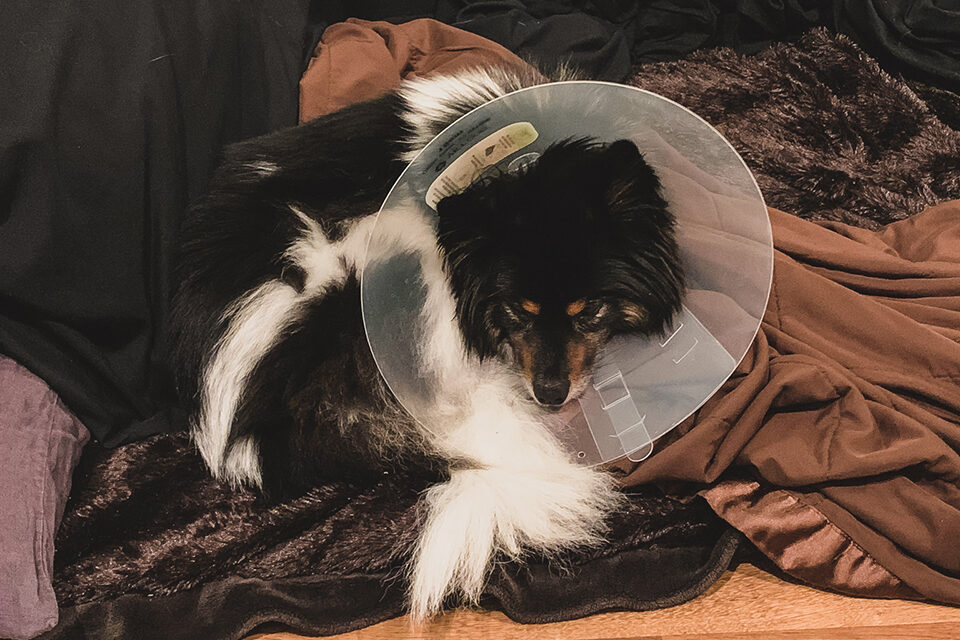Bladder stone surgery in dogs (also known as a cystotomy) was performed on our Pomeranian mixed-breed six months ago.
Luckily, Turtle Dove is now doing splendid, but for a time, things were touch-and-go and quite “rocky.” Literally! Bladder stones are also known as cystic calculi or uroliths. They are minerals that have gathered in the urinary bladder as rock-like formations.
As a dog only two years old at the time, we were shocked when we heard our little dog needed to be put under and have a full cystotomy performed.
Urinary Incontinence to Bladder Stone Surgery in Dogs
It all started when we noticed our Pomeranian was having difficulty urinating — also known as dysuria.
For a few days, he struggled to pee. When doing so, he was only able to urinate in small amounts. We noted this as odd and kept taking him to the bathroom more often.
At the end of the week, and very uncharacteristic of our pup, he had an accident in the house. Later that same day, we noticed blood in his urine, also known as hematuria. We called Broadway Veterinary Hospital here in Sacramento and rushed our dog for an emergency appointment.
From the appointment and after doing x-rays and other tests, they found our dog had a large number of bladder stones accumulated, filling roughly 70% of his bladder.
He needed to have them removed via surgery immediately or suffer a possible death.
They explained that hematuria occurs when the bladder stones start rubbing up on the bladder wall, causing irritation and tissue damage. If the case isn’t severe or there is not blockage, bladder stones can sometimes be resolved through urohydropropulsion (a non-surgical method) or through dietary dissolution.
As a male dog, our Pomeranian was at even greater risk of complications or death if we didn’t have the stones removed. Stones can become lodged in the space between the bladder and urethra and cause a partial obstruction. Bladder stones can also get stuck in the urethra and form a complete blockage that stops a dog from urinating, causing bladder rupture and possible death.
We opted to move forward with the cystotomy surgery immediately.
Fortunately, we scheduled the bladder stone surgery for the following day.
Recovering from Bladder Stone Surgery in Dogs

I dropped our dog off at Broadway Veterinary Hospital the next morning, and they let me know they should be complete with the surgery within a few hours. After the surgery, they would call to update us on how everything went and when we could come to pick him up.
The surgery was successful, and the report was as follows:
ventral midline incision was made cranial to previews. Urinary bladder was isolated and retracted using stay sutures.
An 11 blade was used in surgery to make a stab incision into the bladder. A large curette what use to scoop stones out of the bladder ranging in size from Sand like material to approximately 2 millimeters in diameter.
The amount of stones was too numerous to count.
A 5 French Red Rubber catheter was placed within the urethra and urethrostomy zones were flush back into the bladder using urethera retro
pulsion. Suction was used to remove any remaining Stone material. The bladder incision was closed using 20 monocryl on a tapered needle in a simple continuous pattern with a Cushing’s over so.
Abdomen was checked for potential contamination and a 3-layer routine
closure was performed.
Stones sent for analysis.
Broadway Veterinary Hospital in Sacramento
Although he was groggy and tired from surgery, we were so excited to get him and bring him home. For two weeks post-surgery, we gave our dog various antibiotics and pain medication; Clavamox, Vetprofen, and Gabapentin.
During the post-operative process, we were instructed to keep our dog in its cone for two weeks, minimize movement, and restrict jumping or walking up and down steps.
The first three days post-surgery, our dog was most sore and also suffered from occasional incontinence while the bladder healed. Prepare yourself for a slightly messy experience. We were told it’s normal for some blood to pass and incontinence to occur the first few days post-surgery.
After the first 3–5 days, we found Turtle Dove began rapidly improving and gaining energy.
It’s also essential to routinely check the incision site to ensure no infection is forming with signs of discharge or bleeding and confirm that all sutures are holding. In this case, his sutures dissolved on their own after a month, and didn’t require removal by the veterinarian.
Minimizing the Possibility of Recurrent Bladder Stones in Dogs
After analysis of the bladder stones, they were found to be 100% magnesium ammonium phosphate hexahydrate, also known as struvite bladder stones.
It’s thought that bladder stones can develop as precipitated crystals due to elevated levels of certain elements in a dog’s urine. When there’s a pH or acidity imbalance, the crystals may start to form and grow larger over time. Dogs are known to have at least five different bladder stone types, including struvite, urate, xanthine, cystine, and calcium oxalate bladder stones.
Each stone forms due to different factors, from infection to diet and existent disease.
Since our dog’s bladder stones were struvite, they were most likely caused by a bladder infection.

Additionally, we moved our dog to a special diet these past six months.
This ensures all struvite stones dissolve and don’t recur, in the chance the stones were formed due to a diet imbalance. We currently feed Royal Canin Urinary SO. This specific Royal Canin dog food is formulated to be more acidic to help break down stones and withholds magnesium, proteins, and phosphorus, the building blocks of bladder stones.
We also found that many treats we were giving our dog before his bladder stone diagnosis contained sweet potato as the primary ingredient. Sweet potatoes have high levels of oxalate, a compound that may increase the chances of bladder stones forming.
We’ve since thrown away these treats and stick to alternatives.
Soon we’ll review with our veterinarian if it’s time to come off the special diet or continue. Antibiotics may also be prescribed periodically along with urinalyses to ensure bladder stones aren’t recurring.
Ultimately, going through cystotomy with our dog was worth it to save his life. Although I’m crossing my fingers, we don’t have a repeat.
Notice: The information contained in this article should not be used as a substitute for professional advice. Please consult your veterinarian in all matters related to your pet’s health.
How long is recovery from bladder stone surgery in dogs?
Usually, it takes two weeks for a dog to recover from bladder stone surgery fully. After the first 3–5 days post-surgery, dogs will tend to improve rapidly and return to more normal behavior.
Since our dog was young, through the post-operative process, he healed rather quickly. The difficulty became keeping him from being too rowdy in his second week of healing. Make sure never to leave your dog unattended post-surgery, as they can sometimes get out of their Elizabethan collar and bite at their incision site.
What to expect after your dog has bladder stone surgery?
It can be expected for a dog to refuse food or drink a day or two after bladder surgery. If you’re concerned, don’t panic, and call your veterinarian to confirm normal behavior or signs of potential complications. Additionally, you may see a slight discharge of blood in the urine post-surgery, but it should be minimal and not long-lasting.
How much is dog surgery for bladder stones?
Total costs for our dog’s cystotomy surgery for bladder stones and supporting analysis, post-operative care and medications were $2,300.
The breakdown of these costs includes:
- Cystotomy – $1,500
- Crystallograph Analysis – $145
- Surgical Panel with Fluids – $150
- X-Ray with Two Views – $287
- Hydromorphone – $20
- Cerenia Injectable – $42
- Cefazolin Injectable – $25
- Midazolam Injectable – $20
- Alfaxan – $24
- Rimadyl Injectable – $23
- Clavamox Liquid – $31
- Vetprofen – $20
- Gabapentin – $32
- Elizabethan Collar – $11
Additionally, it was $400 for the initial emergency visit before the surgery. These costs included a $180 emergency exam fee, urinalysis ($75), x-ray ($85), Convenia injectable ($30) and a Meloxicam prescription ($36).
We pay $300 yearly for Lemonade pet insurance. Unfortunately, $0 was covered, as there were signs of a pre-existing gastrointestinal condition noted in our Pomeranian before the coverage date. $3,000 is the total cost for the emergency visit, and bladder surgery was a massive bill to swallow and fit into our yearly budget, and still recovering from the upset.
Are bladder stones in dogs life-threatening?
Yes! Bladder stones in dogs can be life-threatening as the stones can cause complete blockage of urine from passing through the bladder and urethra and lead to a bladder rupture.






